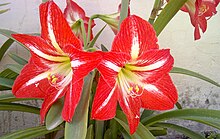Part of the female cannabis plant’s anatomy, referring to all of the reproductive parts of the female plant, including an ovule and two stigmas. Pistils are small, hair-like features on the flower, ranging in color from white to red. When female plants are fertilized, the pistil is activated to collect the male pollen. When plants are unfertilized, the pistils change with time and indicate the ripeness of the plant.
Gynoecium (/ɡaɪˈniːsi.əm, dʒɪˈniːʃi.əm/; from Ancient Greek γυνή (gunḗ) 'woman, female', and οἶκος (oîkos) 'house') is most commonly used as a collective term for the parts of a flower that produce ovules and ultimately develop into the fruit and seeds. The gynoecium is the innermost whorl of a flower; it consists of (one or more) pistils and is typically surrounded by the pollen-producing reproductive organs, the stamens, collectively called the androecium. The gynoecium is often referred to as the "female" portion of the flower, although rather than directly producing female gametes (i.e. egg cells), the gynoecium produces megaspores, each of which develops into a female gametophyte which then produces egg cells.


The term gynoecium is also used by botanists to refer to a cluster of archegonia and any associated modified leaves or stems present on a gametophyte shoot in mosses, liverworts, and hornworts. The corresponding terms for the male parts of those plants are clusters of antheridia within the androecium. Flowers that bear a gynoecium but no stamens are called pistillate or carpellate. Flowers lacking a gynoecium are called staminate.
The gynoecium is often referred to as female because it gives rise to female (egg-producing) gametophytes; however, strictly speaking sporophytes do not have a sex, only gametophytes do. Gynoecium development and arrangement is important in systematic research and identification of angiosperms, but can be the most challenging of the floral parts to interpret.
English
Etymology
Borrowed from French pistil. Doublet of pestle.
Pronunciation
- Rhymes: -ɪstəl
- Homophone: pistol
Noun
pistil
... Read More




